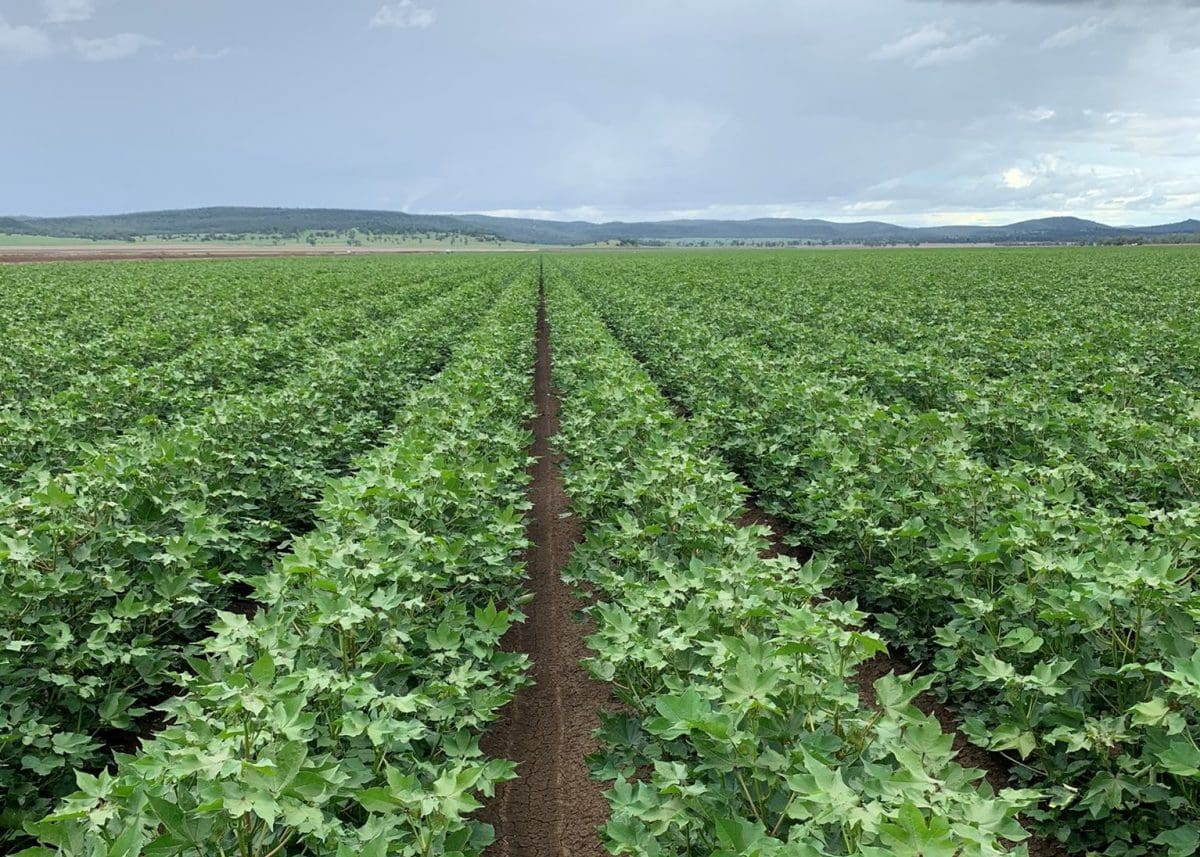
A thriving cotton crop at Boggabri in the Upper Namoi Valley of NSW. Photo: Andrew Watson
PICKING of Australia’s cotton crop is on track to start in Central Queensland (CQ) next month, and while recent rain has missed some growing areas, it has underpinned yield prospects in most.
Rain into December prompted some late planting in Queensland, and crop stages in Queensland and New South Wales vary from early establishment to opening bolls.
Planting of the tropical crop is underway in locations in the Northern Territory, the Ord region of Western Australia and Queensland’s Gulf region, with picking scheduled to take place in winter.
While reduced irrigation prospects have limited national production to around 2.3 million bales (Mb), gross margins are gaining some support from firming prices.
Meanwhile, the WA Government has pledged further funding for a cotton gin in the Ord.
US drop prompts price rise
Left Field Solutions managing director, Pete Johnson, said in the past couple of weeks growers had typically been able to get anywhere from $465/bale to $470/b for cotton at Moree, Narrabri and Dirranbandi, and up to $475/b on the Darling Downs.
Mr Johnson said the main driver behind the price had been expectations of a small United States crop.
“That came to fruition in last week’s USDA WASDE report which dropped the crop in the US below 15Mb. That was a bigger cut than people had expected the USDA to make, but it fell in line with where commercial estimates are,” he said.
Mr Johnson said the factor at play in the market at the moment was that demand was really strong.
“There appears to be some expectation from the retail and wholesale sector that by the time we move into the Northern Hemisphere spring the worst of the COVID pandemic will be behind them and the vaccine rollouts will be taking effect,” he said.
“Over the last 12 months, the fashion stores and retail chains purged their inventories, so they have nothing left. The weavers and spinners have done the same, so they are sitting on very tight inventories.
“All of a sudden we are starting to see demand come back from the wholesalers and retailers. The spinners don’t have the yarn inventory to supply that and at the same time they have to bring capacity back on line, so yarn prices have risen dramatically – probably a 15 per cent kick in yarn values since Christmas.
“That means the spinning margin can support a higher raw cotton price, so we are seeing good strong demand coming through. If COVID persists it can turn everything south again, but it looks good at the moment.”
Mr Johnson said the overall price strength across other commodities such as corn, soybean and wheat could impact the area planted to cotton.
“The cotton price hasn’t risen as much as the corn and soybean price, so there is real concern now that cotton will start to lose area in the Northern Hemisphere,” he said.
Room for more rain
Cotton Australia CEO Adam Kay said lack of rain and water to irrigate at planting time had limited the size of the crop now in the ground, and early summer rain saw some additional area in Queensland go in.
“We’re well planted and up and away,” Mr Kay said.
“We’re hoping for 2.3Mb; that’s half a normal crop, and most people have got enough water to get their crop through.”
Big inflows in recent months for storages in southern New South Wales have its irrigators in an enviable position compared with growers in central and northern NSW, and in most of southern and Central Queensland (CQ).
“Southern NSW is on full allocation, and other regions are better than they were, but everyone would love a flow down the Condamine River to St George and Dirranbandi.
CQ first to pick
In CQ, CSD agronomist Stewart Brotherton said early planted crops will be picked from mid-February through to April.
“Growers planted a limited amount, and some was walked away from because they ran short of irrigations.
“Some people have planted later, and only had 40-60 millimetres over the Christmas-New Year, so they’ve had late emergence.”
CQ normally starts planting in early August, and plants the later crop in November.
“This year, there was a general spread to limit risk and play the weather in the hope of getting rain.”
Mr Brotherton said early planted crops should yield well, but results from later crops would be mixed.
“It’s probably the middle or the later crops that will need rain.
The Emerald region of CQ can plant up to 23,000 hectares when water for irrigation is plentiful.
However, only around 3500ha is currently in the ground.
Emerald has two gins which are usually the first to open for the season.
They are both expected to operate this year, but for a shorter period than normal due to the small crop size.
South-east of Emerald in the Dawson-Callide region, a better water situation has allowed a full plant of around 4500ha.
Grain Central: Get our free cropping news straight to your inbox – Click here

HAVE YOUR SAY